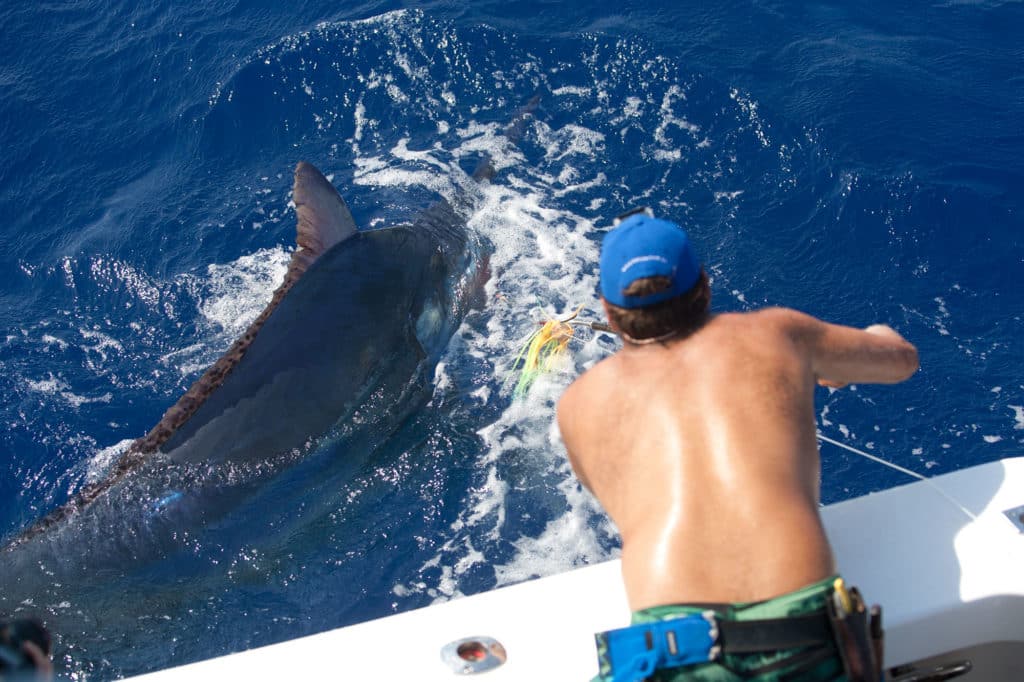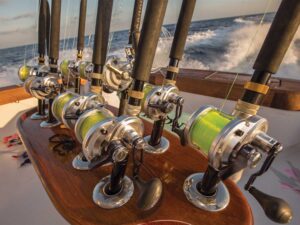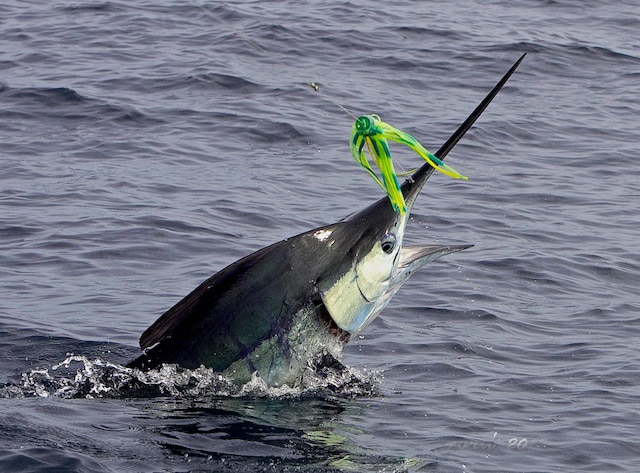
A very good friend of mine and a great teacher, Hawaiian Capt. Mike Rand, once said to me, “Marlin fishing is a simple thing that we make complicated, only to realize just how simple it is.” No truer words have been spoke
As an avid fisherman and lure maker, I made it my goal to understand how to be more successful when trolling for billfish, and then use that insight to help make lures that produce the best possible results. I’ve been lucky enough to fish in some of the best lure fisheries in the world and to learn from some of the best lure makers and captains in these places. I combined their experience with my own ideas, gained from my time running boats, working cockpits and designing and making lures. There are many theories regarding lure fishing that get bandied about, some of which just provide food for thought and others that seem to actually make a difference out on the water.
However, some would argue that the practice of trolling lures really has evolved quite a bit since I first started fishing. Those of us who take it seriously have come a long way from the old “drag ’em and snag ’em” days.

Factors
I think it’s helpful to break lure fishing down into the factors that we can control and those that we can’t. We can control where we fish (within reason), what sort of lures we fish, how we arrange the lures in the spread, how we rig the lures and what drag settings we use.
We can’t control whether the fish are on the chew, or the weather and sea conditions we may face on any given day.
Since there’s no need to fret over things I can’t change, I like to focus on the factors that I can control, and to direct my efforts toward getting an aggressive bite. It’s much harder to hook a fish on a lure when you don’t get an aggressive bite out of the fish. When I fished in Bermuda this past summer, the fish were uncharacteristically lazy on the bite. We got a few committed crash bites that blue marlin are normally associated with, but most of the fish we saw would take a halfhearted swipe at the lure, pull it out of the rigger and then start to follow. That’s a frustrating situation, but it is also the type of situation where some sound thinking about lure patterns and rigging can make all the difference in your day.
It almost goes without saying that you’ll get your best results if you fish where the fish are, but many recreational fishermen don’t take the time to find out where the fish are holding before committing to a fishing trip. They simply go where they found action and success during their last trip. But as we all know, a lot can change over just a few days, let alone in the weeks and months that pass between most recreational trips. The end result is often a large fuel bill and no bites! So, a gentle reminder: Try to find out where the fish are biting as best you can before leaving the dock. Either spend some time rubbing elbows with the local charter captains or use a good fish-forecasting service, like ROFFS or Hilton’s, before leaving the dock.
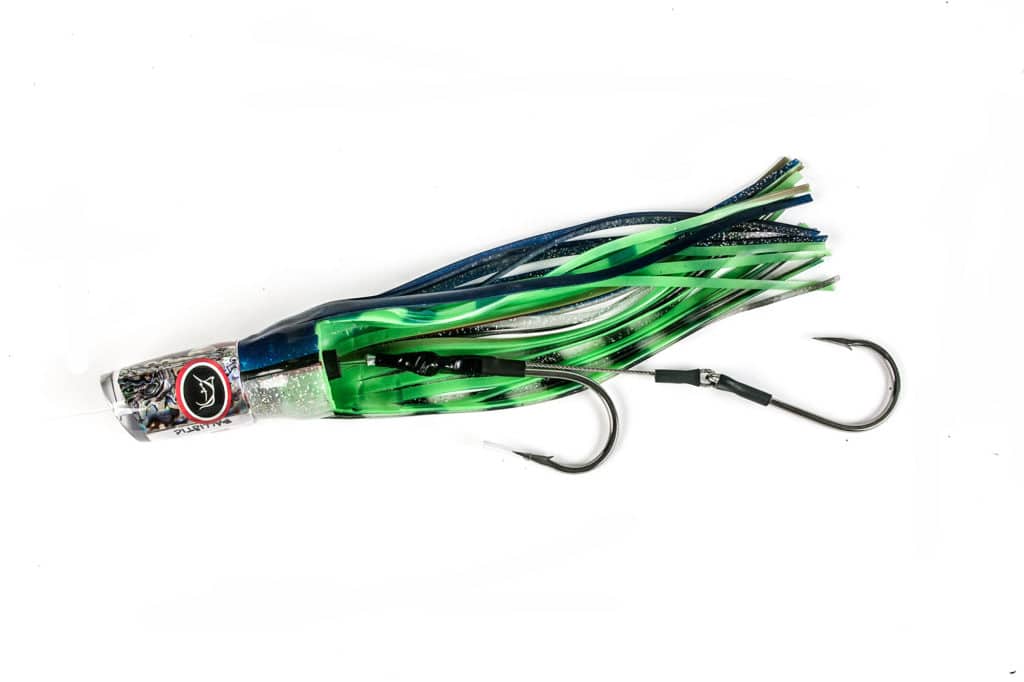
The Spread
I believe that if I can get my lures running in the right spot and at the optimal speed, they will raise more fish, and, in turn, I’ll get the chance to get more hooks into the fish. I pay a lot of attention to the action of the lures I plan on running. Experience has taught me that I will have the most success if I can get the fish to tell me what they want to eat on any given day. On some days, the marlin seem to only want to eat the splashy, noisy surface lures. On other days, the fish bite deep-diving lures more readily, or sometimes only the lazy running lures fished out of the long rigger prove to be successful. Therefore, I set up my lure pattern around these three lure actions, as they all have a place and a purpose. It’s all about giving the fish a choice. Make sure there are ample menu options available, but remember that the secret is how you put the menu items together!
I like to run my lures in pairs. The first pair of lures are my corner lures, and these are generally my largest lures. The pair is made up of an aggressive surface lure on one side and a deep-diving lure on the other side. I then take this same rule of pairing lures with opposite actions and apply it to the next pair of lures on the riggers. These lures are generally smaller.
Finally, the last lure in the spread is my shotgun, or stinger, lure, which is the one farthest away from the transom. In this position, I tend to run something smaller in size with a lazy action, such as a bullet, like my Bonze Darter. Everyone in Hawaii pulls a tuna jet down the center, and for that reason alone, more 1,000-pound marlin have probably been caught on a bullet lure with the action of a dishrag than any other lure.
This shotgun lure represents the last option in the spread, and as I mentioned earlier, you never know what the fish will want to eat that day. The shotgun lure stands out clearly in its way-back position. That lazy, quiet lure way out in the back looks like an easy meal to a marauding marlin!
The reasoning behind pairing lures with contrasting actions is to trigger that aggressive bite. I believe the contrasting actions make the menu items look more appealing to our target species. The splashy surface lure provides a contrast to the deep-diving lure running on the opposite side, sometimes triggering a bite on the surface lure. On other days, the deep-diving lure gets all the action, assisted by the contrast provided by the noisy surface lure. For example, I have found that even if the fish comes up on the splashy lure and sits behind it, the fish will often see the easy, deep-diving target opposite and race across and aggressively attack that or fall back onto the smaller lures farther back in the spread. Sometimes the marlin will fall all the way back to the lazy lure on the shotgun, which is just screaming “Eat me!”
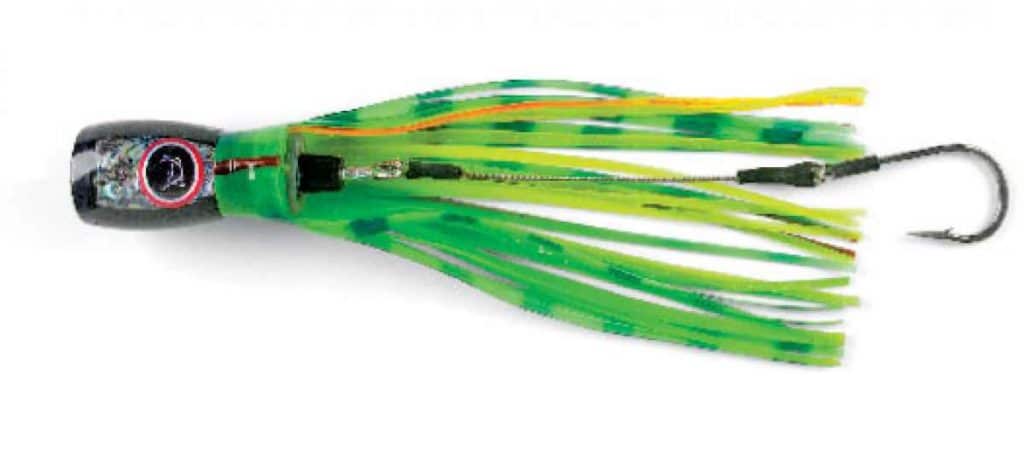
Hooks and Rigs
Imagine how much easier it would be to hook a marlin if it didn’t have that pesky bill in front of its mouth! Essentially, the hook rigs are going to make the lures run as I want them to, and thus help me to achieve the result I want. Let’s start with my splashy surface lures. This style of lure has an aggressively angled face, which creates all the noise and commotion. The problem with these lures is that they are generally very sensitive to how they are rigged, so you have to get it right. As I said before, this style of lure normally produces an aggressive bite, so I concentrate my rigging around performance first and hookup rate second. I like to rig these lures with a 180-degree double-hook rig with a swinging trailing hook. I always position the front hook facing up in the lure. I believe that this rigging will give the lure the best chance of running to its optimum potential.
What about the deep-diving and lazy lures, which are normally cup faced, or the bullet lures I run farther back in the spread? In contrast to my approach to the surface lures, I tend to rig my deep divers and bullet lures for hookup rate first and action second. This is possible because the actions of these lures are not affected as much by the hook rig as the angle-faced surface lures. The rig I use in these deep divers and bullet lures is a single swinging hook-set moved as far back in the skirt as possible. I am trying to hook the marlin from the outside in. By using this single swinging hook-set positioned well back, I feel that I am lessening the chances of bill wraps, as this setup allows the bill to slide across the lure without the hook catching straight away, as is often the case with a twin-hook rig. If everything goes according to plan, by the time the lure has slipped through the marlin’s mouth, the hook should be closer to the base of the bill or to the face of the fish. And the base of the bill and the open mouth provide a much larger target area for the hook to find its mark.
I also like to use a closed-gape style of hook in all my rigs, and this is why I leave my rigs loose. I find that if I leave the single-hook rig and the trailing hook of the double rig loose, it lets the hook pull itself into the fish at the slightest chance that the point digs in. I have caught a number of fish whose bills have been hooked. These fish obviously had the hook around their bills, and the hook probably would have slid off if it had been stiff-rigged, since this does not allow the hook to naturally pull in.
The other benefit of this rig is that, if the fish comes from behind the lure, the hook is as far down the fish’s throat as possible. And if you get a really aggressive crash bite on this rig, you are usually going to get a hook into the fish.
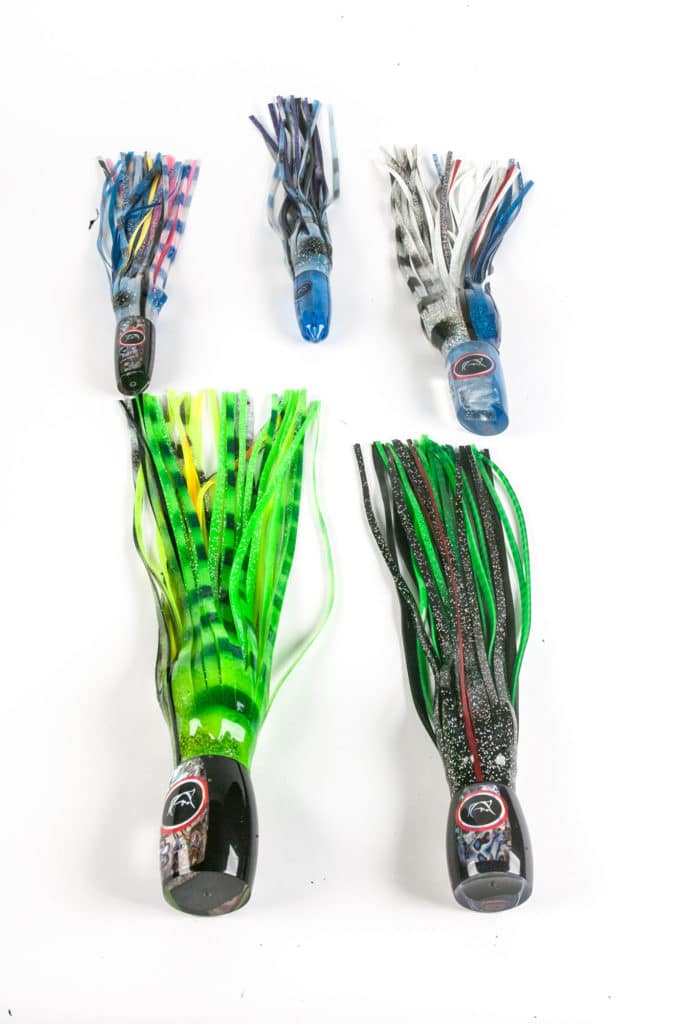
Drag and Outrigger Tensions
Once I have my lure spread set and rigged, I turn my attention to the release tension on the riggers. This can be an area of real controversy, just like drag settings. My approach is to make the release from the rigger as difficult as practically possible. I believe that if the clip or rubber band is hard to break, the fish actually has to grab the lure with conviction to get hold of it. The more aggressively the fish grabs the lure, the better the chance of eventually hooking the fish. A light clip setting, or band that can break with the lightest of bill swipes, does not force the fish to commit to the bite.
Finally, I look at which drag settings I use. My choice of drag settings is a function of the line weight I’m fishing with, but generally I will set the drag at one-third the breaking strain of the line. Therefore, on 37-kilogram (80-pound) line, I am using 12 kilograms (26 pounds) of drag on the strike. I know that many captains and anglers prefer to use light drag settings, and they do quite well with that approach. But I like to make sure that when the marlin eats the lure, it’s either hooked straight away or the lure is pulled away from the fish but remains inside the spread, giving me the chance to get another shot at a second bite. My time on the water, especially in fisheries like Cape Verde, where there are large numbers of fish to experiment on, taught me that a hard drag, combined with a hard release system, maximizes the small window of opportunity we get to hook a fish on a lure.
My approach emphasizes giving the fish the chance to show you what it wants to eat and making sure that your lures work together as a complementary set and are not just a gaggle of different lures randomly placed behind the boat.
